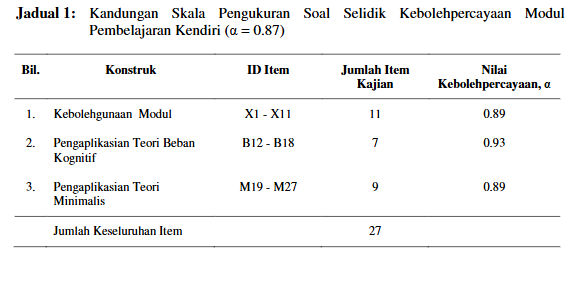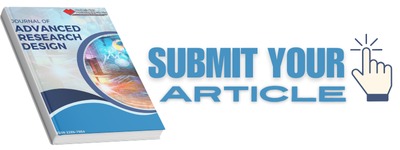Kesahan dan Kebolehpercayaan Soal Selidik Kebolehgunaan Modul Pembelajaran Kendiri Menggunakan Model Pengukuran Rasch (Validity and Reliability of Questionnaire to Measure Usability of a Self-Learning Module Using the Rasch Measurement Model)
Keywords:
Self-learning Module, Rasch Measurement Model, item polarity, questionnaire validationAbstract
A questionnaire Usability Self Learning Module is developed to measure the overall development of the learning module Adobe Photoshop constructs involving three modules, module’s usability, applying theory of the cognitive load and minimalist. The study was conducted to produce empirical data on the reliability and validity of the Usability of Adobe Photoshop’s Module questionnaire using the Rasch Measurement Model. A survey was conducted on 120 participants who attended the course Adobe Photoshop using the modules studied. The questionnaire is distributed using one of the Web 2.0 technology platform, Google Docs. The reliability and validity of the Usability Adobe Photoshop’s module questionnaire were tested with the Rasch Measurement Model
using the Winstep version 3.69.1.11 program.The Rasch analysis showed that person reliability index is 0.87 and item reliability of 0.94. In term of item polarity, each item was able to contribute to measuring the effectiveness of the learning module development measurement since the PTMEA CORR exceeded 0.30, in specific between 0.50 to 0.78. There are 27 items in the questionnaire, which is divided into 3 different constructs. Each construct contains 7 to 11 items. The unidimensionality test conducted showed standardized residuals variance of 49.8%, with the biggest secondary dimension in the first constrast amounting variance of 6.5%. Item fit analysis showed that none of the items needed to be dropped since infit mean square values are between 0.73 and 1.39, and the outfit mean square values are between 0.70 and 1.40. Items in the questionnaires are ordered in a continuum of increasing intensity for the measurement of the Usability of Module construct. This shows the validity of the constructs in Usability of the module.The Rasch Measurement Model shows that the Usability
of the Module has a high reliability and validity to be used for measuring the usability of the module and the application of cognitive load theory and the theory of minimalism.
Downloads



















